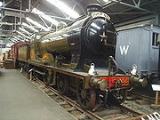
NBR K Class
Encyclopedia
The NBR K Class is a class of 4-4-0
steam locomotive
of the North British Railway
. The first batch (later LNER Class D26) was designed by Matthew Holmes
in 1902 and had 6' 6" driving wheels for express passenger work. Three more batches (later LNER Classes D32/D33/D34) were designed by William P. Reid
with 6' 0" driving wheels for mixed traffic work. This included perishable goods, such as fish from Mallaig
and Aberdeen
. They had inside cylinders and Stephenson valve gear
. Later locomotives had superheater
s.
in 1903. Three were withdrawn in 1922, leaving nine to enter LNER ownership in 1923. These nine had all been withdrawn by July 1926.
(LNER) in 1923 and, some of them, to British Railways (BR) in 1948. BR numbers were:
One, 256 Glen Douglas (BR number 62469) has been preserved by the Scottish Railway Preservation Society
.
4-4-0
Under the Whyte notation for the classification of steam locomotives, 4-4-0 represents the wheel arrangement of four leading wheels on two axles , four powered and coupled driving wheels on two axles, and no trailing wheels...
steam locomotive
Steam locomotive
A steam locomotive is a railway locomotive that produces its power through a steam engine. These locomotives are fueled by burning some combustible material, usually coal, wood or oil, to produce steam in a boiler, which drives the steam engine...
of the North British Railway
North British Railway
The North British Railway was a Scottish railway company that was absorbed into the London and North Eastern Railway at the Grouping in 1923.-History:...
. The first batch (later LNER Class D26) was designed by Matthew Holmes
Matthew Holmes
Matthew Holmes was Chief Mechanical Engineer of the North British Railway from 1882 to 1903..-Locomotives:Locomotives designed by M. Holmes include:* NBR Class C, later LNER Class J36, 0-6-0...
in 1902 and had 6' 6" driving wheels for express passenger work. Three more batches (later LNER Classes D32/D33/D34) were designed by William P. Reid
William P. Reid
William Paton Reid was apprenticed to the Cowlairs railway works of the North British Railway in 1879 and was Locomotive Superintendent from 1903-1919. He was awarded a CBE in 1920. He was born, and died, in Glasgow, Scotland...
with 6' 0" driving wheels for mixed traffic work. This included perishable goods, such as fish from Mallaig
Mallaig
Mallaig ; is a port in Lochaber, on the west coast of the Highlands of Scotland. The local railway station, Mallaig, is the terminus of the West Highland railway line , completed in 1901, and the town is linked to Fort William by the A830 road – the "Road to the Isles".The village of Mallaig...
and Aberdeen
Aberdeen
Aberdeen is Scotland's third most populous city, one of Scotland's 32 local government council areas and the United Kingdom's 25th most populous city, with an official population estimate of ....
. They had inside cylinders and Stephenson valve gear
Stephenson valve gear
The Stephenson valve gear or Stephenson link or shifting link is a simple design of valve gear that was widely used throughout the world for all kinds of steam engine. It is named after Robert Stephenson but was actually invented by his employees....
. Later locomotives had superheater
Superheater
A superheater is a device used to convert saturated steam or wet steam into dry steam used for power generation or processes. There are three types of superheaters namely: radiant, convection, and separately fired...
s.
LNER Class D26
Twelve engines ordered in March 1902 and built at Cowlairs railway worksCowlairs railway works
Cowlairs Locomotive, Carriage and Wagon Works , at Cowlairs in Springburn, an area in the north-east of Glasgow, Scotland, was built in 1841 for the Edinburgh and Glasgow Railway and was taken over by the North British Railway in 1865. It was named after the nearby mansion of Cowlairs, with both...
in 1903. Three were withdrawn in 1922, leaving nine to enter LNER ownership in 1923. These nine had all been withdrawn by July 1926.
LNER Class D32
Twelve engines ordered in 1905 and built at Cowlairs in 1906-7. The LNER began to fit superheated boilers in 1923 and classified the superheated locomotives D32/2. The non-superheated locomotives were classified D32/1.LNER Class D33
Twelve engines built at Cowlairs in 1909-10. The LNER fitted superheaters to all the D33s between 1925 and 1936.LNER Class D34
Ten engines built at Cowlairs in 1913. Twenty-two engines built between 1917 and 1920. All the D34s were built with superheaters.Post-NBR
The locomotives passed to the London and North Eastern RailwayLondon and North Eastern Railway
The London and North Eastern Railway was the second-largest of the "Big Four" railway companies created by the Railways Act 1921 in Britain...
(LNER) in 1923 and, some of them, to British Railways (BR) in 1948. BR numbers were:
- D32, five locomotives, 62445-62454 (with gaps)
- D33, nine locomotives, 62455-62466 (with gaps)
- D34, thirty locomotives, 62467-62498 (with gaps)
Names
The D34s were named after Scottish Glens:
|
|
|
Preservation
Withdrawals began in 1946 and all the D34s had been withdrawn by 1961.One, 256 Glen Douglas (BR number 62469) has been preserved by the Scottish Railway Preservation Society
Scottish Railway Preservation Society
The Scottish Railway Preservation Society is a charity, whose principal objective is the preservation and advancement of railway heritage in Scotland. The Society was formed in 1961, and it has been actively collecting and displaying railway artifacts of Scottish significance ever since...
.

